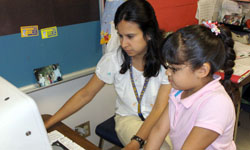

Thinking with Data
Teaching and Learning Strategies
Thinking with Data
Not long ago, the information people needed for decision making was simple and at hand. Today, as life continues to grow more complex, information is becoming more pervasive and ambiguous than ever. Therefore, success in learning and in life requires an understanding of how to effectively interpret and use data.
As consumers, we use data in our everyday lives—to choose medications or health practices, to decide on a place to live, or to make judgments about education, policy, and practice. As literate citizens of a democratic society, we are called upon to reason and interpret data intelligently. The newspapers and TV news are full of data about nutrition, side effects of popular drugs, and polls for current elections that we need to interpret intelligently. To think with this data, we must judge the reliability of what we read, see, and hear, and make critical and subtle distinctions as we think about the data that is thrown our way (Rubin, 2005).
Importance of Thinking with Data >
Through the Internet and other mass media, 21st Century citizens have access to almost unlimited amounts of data on an endless number of topics. Authentic experiences using real data in the classroom prepare learners to use data effectively and responsibly in their lives.
Skills Used in Thinking with Data >
Thinking with data is a specific type of thinking that includes many 21st century skills, particularly problem solving, critical and systems thinking, creativity, and communication.
Thinking with Data in the Classroom >
Students learn to think with data, first, by working on projects that require the collection, analysis, and interpretation of data.
Learners in primary grades can develop basic skills in collecting and analyzing data. For example, in Meet the Bears*, second graders look at bears from all angles to answer the Focus Question, Are we like other animals?
After a car and pedestrian accident occurs near the local school, concernedGrade 5 learners, parents, and neighbours collect and interpret data to launch a neighbourhood safety project in Red Light, Green Light*.
Using actual wildlife injury data from a local wildlife rescue centre, Senior Phase learners learn what animal species have been injured and the causes of injury in What Happened to Robin?*
In Track the Trends*, high school learners take on the role of statisticians by choosing a subject of interest and collecting statistical information about the subject over time and predict the implications of their findings.
References
Beyer, B. K. (2000). Teaching thinking skills—Defining the problem. In A. L. Costa (Ed.), Developing minds: A resource book for teaching thinking (pp. 35–40). Alexandria, VA: ASCD.
Friel, S. N., & Bright, G. W. (1998). Teach-Stat: A model for professional development in data analysis and statistics for teachers K–6. In S. P. Lajoie (Ed.), Reflections on statistics: Learning, teaching, and assessment in grades K–12 (pp. 89–117). Mahwha, NJ: Erlbaum.
Konald, C., & Higgins, T. L. (2003). Reasoning about data. In J. Kilpatrick, W. G. Martin, & D. Schifter (Eds.), A research companion to principles and standards for school mathematics (pp. 193–215). Reston, VA: NCTM.
Moore, D. (1990). Uncertainty. In L. A. Steen (Ed), On the shoulders of giants: New approaches to numeracy (pp. 95–138). Washington, DC: National Academy Press.
Rubin, A. (2005). Math that matters. Hands On: A Journal for Mathematics and Science Educators, 28(1), 3–7.
Swartz, R. J. (2000). Thinking about decisions. In A. L. Costa (Ed.), Developing minds: A resource book for teaching thinking (pp. 58–66). Alexandria, VA: ASCD
